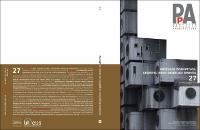Por favor, use este identificador para citar o enlazar este ítem:
https://repositorio.usj.es/handle/123456789/869
Registro completo de metadatos
| Campo DC | Valor | Lengua/Idioma |
|---|---|---|
| dc.contributor.author | Grávalos Lacambra, Ignacio | - |
| dc.date.accessioned | 2022-11-21T09:48:56Z | - |
| dc.date.available | 2022-11-21T09:48:56Z | - |
| dc.date.issued | 2022-11-20 | - |
| dc.identifier.citation | I. GRÁVALOS LACAMBRA. El imaginario fílmico suburbial de los años sesenta. El fin.. Proyecto, Progreso, Arquitectura. Noviembre 2022. E. Universidad de Sevilla. ISSN 2171–6897 / ISSNe 2173–1616 | en_US |
| dc.identifier.issn | 2171–6897 | en_US |
| dc.identifier.uri | https://repositorio.usj.es/handle/123456789/869 | - |
| dc.description | After the Second World War, cities experienced a sharp increase in population, forcing them to expand their limits and reconfigure the relationship between the centre and the periphery. Suburban complexes appeared which, under the precepts of science and promises of progress, looked forward to a new future with great optimism. By the mid-1960s, the reality was quite different. These settings were highly conflictive, a situation that was reflected in film production. This article explores the introduction of an urban critique in a certain filmography of that period through three films that are representative of this way of showing both the new suburban complexes and the mega-structures. In Two or Three Things I know About Her (Godard, 1967), A Clockwork Orange (Kubrick, 1971) or Shivers (Cronenberg, 1975) urban proposals have a radical prominence, relating the spaces of the suburb as spaces of loneliness or violence. All of them contributed greatly to the formation of a negative urban imaginary that would spread across the modern movement, putting an end to the utopias that had been formulated concerning the city of the future. | en_US |
| dc.description.abstract | A partir de la segunda guerra mundial las ciudades experimentaron un acusado incremento de población, debiendo expandir sus límites y reconfigurando la relación centro-periferia. Aparecieron conjuntos suburbanos que, bajo los preceptos de la ciencia y las promesas del progreso, auspiciaban con gran optimismo un nuevo futuro. A mediados de los años sesenta la realidad era bien distinta. Estas actuaciones mostraron grandes niveles de conflictividad, situación que fue reflejada en la producción cinematográfica. El artículo indaga sobre la introducción de una crítica urbana en cierta filmografía de ese período a través de tres películas representativas de esta manera de relatar tanto los nuevos conjuntos suburbiales como las megaestructuras. En Dos o tres cosas que yo sé de ella (Godard, 1967), La naranja mecánica (Kubrick, 1971) o Vinieron de dentro de… (Cronenberg, 1975) las propuestas urbanas van a tener un protagonismo radical, relatándose los espacios del suburbio como los espacios de la soledad o de la violencia. Todas ellas contribuyeron en gran medida a la conformación de un imaginario urbano negativo que se iba a extender sobre el movimiento moderno, poniendo fin a las utopías que se habían formulado sobre la ciudad del futuro. | en_US |
| dc.format.extent | 16 p. | en_US |
| dc.format.mimetype | application/pdf | en_US |
| dc.language.iso | spa | en_US |
| dc.publisher | Univeridad de Sevilla | en_US |
| dc.relation.requires | adobe/ PDF | en_US |
| dc.rights | Attribution-NonCommercial-NoDerivatives 4.0 Internacional | * |
| dc.rights.uri | http://creativecommons.org/licenses/by-nc-nd/4.0/ | * |
| dc.subject | Arquitectura y cine | en_US |
| dc.subject | Ciudad satélite | en_US |
| dc.subject | Megaestructura | en_US |
| dc.subject | Suburbio | en_US |
| dc.subject | Imaginario urbano | en_US |
| dc.subject | Architecture and cinema | en_US |
| dc.subject | Satellite city | en_US |
| dc.subject | Mega-structure | en_US |
| dc.subject | Suburb | en_US |
| dc.subject | Urban imaginary | en_US |
| dc.title | El imaginario fílmico suburbial de los años sesenta. El fin de las utopías modernas | en_US |
| dc.type | journal article | es_ES |
| dc.identifier.publicationfirstpage | 16 | en_US |
| dc.identifier.publicationlastpage | 31 | en_US |
| dc.identifier.doi | https://dx.doi.org/10.12795/ppa.2022.i27.01 | en_US |
| dc.rights.accessRights | open access | es_ES |
| Aparece en las colecciones: | Artículos de revistas | |
Ficheros en este ítem:
| Fichero | Descripción | Tamaño | Formato | |
|---|---|---|---|---|
| EL IMAGINARIO FÍLMICO SUBURBIAL DE LOS AÑOS 60..pdf | 3,67 MB | Adobe PDF |  Visualizar/Abrir |
Este ítem está sujeto a una licencia Creative Commons Licencia Creative Commons

